HOTELS IN JAPAN
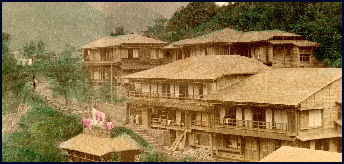
a nice ryokan in
the Fuji-Hakone area
in the early 20th century Tourist facilities are first rate but expensive in Japan. The major cities and tourist areas have everything from luxury hotels to hostels to traditional Japanese-style accommodations such as “ryokans” and “minshukus”. Local tourist offices in Japan can usually help you find a place to stay.
The main problem is finding the hotels. Some are identified only by Japanese characters; others are hard to locate in the big cities. It is good idea to book a hotel before you arrive in Japan and get detailed instructions of how to find it.
Accommodation prices are set by the government so that hotels of similar quality usually don't vary in price that much. Some discount coupons are available. A tax of three percent is levied on bills under 15,000 yen and a tax of six percent is added for bills over 15,000 yen.
There isn't much cheap accommodation in Japan. Stay clear of the Love Hotels unless you want something more than a place to sleep. The Lonely Planet Guides are recommended for their descriptions of budget hotels. The Japan National Tourist Organization puts out travel guides with lists of hotels.
About 3,000 inns and hotels in Japan are registered as places where “foreigners can stay in comfort.” To be registered as such they are supposed to have a senior staff member able to interact with foreigners and be able provide information to foreign guests. One survey found that many of those registered were it unable to meet these criteria.
Hotel Comments and Safety in Japan
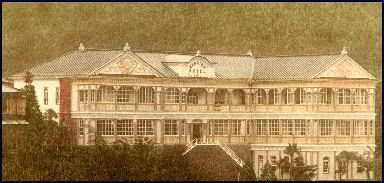
a nice hotel in
the Fuji-Hakone area
in the early 20th century 1) Prices are generally given on a per person rather than per room basis; 2) In a “ryokan” (traditional inn) you take your shoes off before entering the room and sleep on the floor. In Western-style hotels you keep your shoes on and sleep on a bed. 3) Sometimes people take a shower on the floor of the bathroom rather in the bathtub. 4) The pillows tend to be hard. 5) the rooms are often hot in the winter (you may need to open a window).
6) Hotel rooms in Japan tend to be small but cleverly designed. Bathrooms often have sinks and bathes served by the same faucet and beds sometimes are combined with a desk and night table. 7) Make sure to get a hotel card with name, address and phone number of the hotel in Japanese and English, and preferably a map. If you get lost you can always show it to a taxi driver to get back to your hotel.
8) If you haven't booked a hotel in advance and you traveling in the high season, or to a popular place, start looking for a accommodation early, preferable around 11:00am or 12:00am, when other people are checking out. 9) Don't make telephone calls, especially long distance calls, if you can help it. Some hotels charges up to US$8.00 a minute for calls to the United States. 10) Sometimes price reductions are offered for travel in the off peak season or on weekends. There are a fair number of Internet deals out there. Some are only available on Japanese sites.
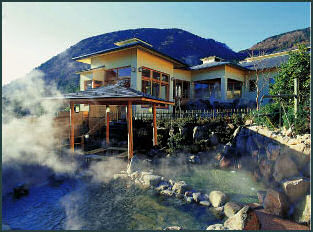
a nice modern ryokan
in the Fuji-Hakone area 11) Some traditional Japanese inns are not very welcoming to foreign visitors. This is not necessarily because they are prejudiced against foreigners but more often because they worry that foreigner will not follow the proper etiquette and they might argue over the bill because they are not familiar with the Japanese pricing system, particularly the fact that guests pay on a per person basis rather than a per room basis.
12) Hotel rooms generally have a pot for making hot water for tea and a small empty refrigerator. 13) Laundry service is sometimes available. Ask how much it is. Sometimes it is quite expensive. 14) Sometimes the showers are a little strange and the towels are small and made of relatively thin coarse cloth rather than terry cloth. Soap and shampoo are often supplied by large dispensers. Some places supply disposable toothbrushes with toothpaste impeded on the bristles.
15) Some places offer breakfast, often rolls, coffee and juice. Some don’t. 16) Only the most expensive hotels have room service. Make sure you have some snacks for when you get hungry. 17) Many hotels have only Japanese television channels. Even many of best hotels don’t offer CNN or cable or satellite televison. 18) Many hotels have luggage transfer services that will transport your luggage to your next destination, often in less than 24 hours.
Hotel Fire Safety: 1) locate the nearest fire escapes, fire extinguishers and air conditioner off switch (air conditioners can suck smoke into a room); 2) Keep your room key handy; 3) never use the elevator if a fire threatens; 4) if all exits are blocked go back to your room and place wet towels under the door and over the air vents and fill the bathtub and sinks with water and use the wastebasket or ice bucket to moisten hot walls and keep towels wet.; 5) call the location of the fire to the front desk or the fire department; and 6) stay low below the smoke and poisonous gases and place a wet towel over your nose and mouth to serve as a filter
Hotel Reservations and Rules in Japan

inside a nice ryojen-onsen in Beppu Reservations are strongly advised, especially during the peak tourist season (New Years, late April, early May and August). The Japan National Tourist Organization can provide you with lists of hotels but they generally can not make hotel arrangements for you. You will have to contact a travel agency, hotel representative or write to the hotels directly. The local tourist offices in Japan can usually help you find a place.
Reservations can be done two ways: 1) Through your local travel agent or a hotel representative. 2) By writing, cabling, e-mailing or faxing a hotel directly. If you do it this way make sure and tell the hotel the number of people in your party, the type of accommodation desired (single/double, with/or without private bath), the dates of arrival and departure, and your choice of meal plan. Many hotels prefer the messages to be faxed and require a credit number. A deposit is sometimes required to validate a reservation.
Tourist Offices: The people who work at the tourist offices in Japan are generally very helpful and knowledgeable about hotels. They can usually help you find accommodation whether it be a five star hotel or a hostel. Japanese National Tourist Organization office in you home country can supply you with hotel guides:
It is often possible to get off a train and have the people at the tourist office in the train station set up a hotel for you in a few minutes. The tourist office can sometimes even book a room for you in another city and help you transport your luggage to you next destination so you don’t have to carry it.
The tourist offices in the train stations are generally open from around 9:00am to 5:00pm. Similar services are available at the airports. The airport offices are sometimes open late and offer assistance for late arriving flights.
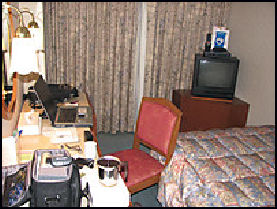
inside a typical
business hotel room Japanese National Tourist Organization office in your home country and their website has fairly comprehensive lists of hotels, apartment hotels, villas, motels, pensions (guest houses), and campsites. Hotel lists for specific areas or resorts are available through local tourist boards.
Check in and Checkout Times: Check-in is usually after 3:00pm and check-out is before noon. Reserved rooms must generally be occupied by 6:00pm on the day of arrival. Unless the hotel has been notified of a late arrival or the reservation have been guaranteed by a deposit, it has the right to dispose of the room.
Hotel Websites for Japan
Japan Hotel Web Sites: JapanHotel.net JapanHotel.net ; Japanese Lifestyle Japanese Lifestyle ;Japanese Guesthouses Japanese Guesthouses ;Japan Traveler Online Japan Traveler Online
Asia-Oriented Websites include Asia Rooms Asia Rooms ; Asia Travel Asia Travel ;Traveller Traveller ; Asia Voyage Asia Voyage and Asia Hotels Asia Hotels
Worldwide Hotel Web Sites: Hotels.com Hotels tel.800-219-4606, 800-364-0291; Expedia Expedia tel.800-397-3342 ; Travelocity: Travelocity tel.888-709-5983 ; Orbitz.com: Orbitz tel.888-656-4546 ; PlacestoStay PlacestoStay.com:
Web sites with Traveler Reviews: TripAdvisor.com: Trip Advisor ; Travelocity: Travelocity ; Fodors.com: Fodors ; Lonely Planet Hotels Lonely Planet
HOTELS IN JAPAN
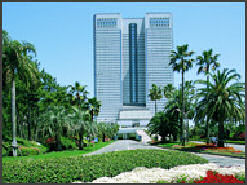
Seagaia Sheraton
in Miyazaki First Class Hotels in Tokyo and other major cities are rated among the best in the world. They usually have English-speaking staff members, amenities similar to those in Western hotels, a choice of restaurants, coffee shops open around the clock, expensive room service, conference services, business center, a health club, a small swimming pool, beauty salon, shopping/travel counter, baby sitters, safe deposit lockers, currency exchange banks, rooms with attached baths, channel music, cable TV, and telephones with direct dial facilities.
Some hotels have interpreter and translator services, secretarial services and access to fax machines and computers. Most deluxe and first-class hotels in Tokyo, Osaka, Kyoto, Kobe and Sapporo have direct connections on limousine buses to the airport. Reservations can obtained through travel agencies and prices for double rooms range from US$150 to US$300 per night. A 10 to 20 percent service tax is added to the price at most first class hotels.
Sheraton (☎ 800-325-3535), Westin (☎ 800-228-3000), Hyatt (☎ 800-233-1234), Hilton (☎ 800-445-8667), Ramada Inn (☎ 800-272-6232), Holiday Inn (☎ 800-HOLIDAY), Best Western International (☎ 800-528-1234), Marriot (☎ 800-228-9290), Choice Hotels (☎ 800-221-2222), Radisson Hotels (☎ 800-333-3333) and Inter-Continental (☎ 800-327-0200) have hotels in Japan.
Business Hotels are no-frills lodging aimed mainly at traveling Japanese businessmen. Found in all major and many mid-sized cities, business hotels and generally clean and comfortable, these hotels are usually smaller and offer fewer amenities than first class hotels. Many are found near train stations. Most have a restaurant as well as drink and snack vending machines on each floor.
Most rooms are singles because the layout of these hotels is designed for the Japanese business person. The rooms however generally have Western-style furniture and attached baths. Most business hotels are conveniently located near train stations and prices for single rooms range from US$65 to US$85 per night. English may or may nor be spoken. Website: JapanHotel.net JapanHotel.net
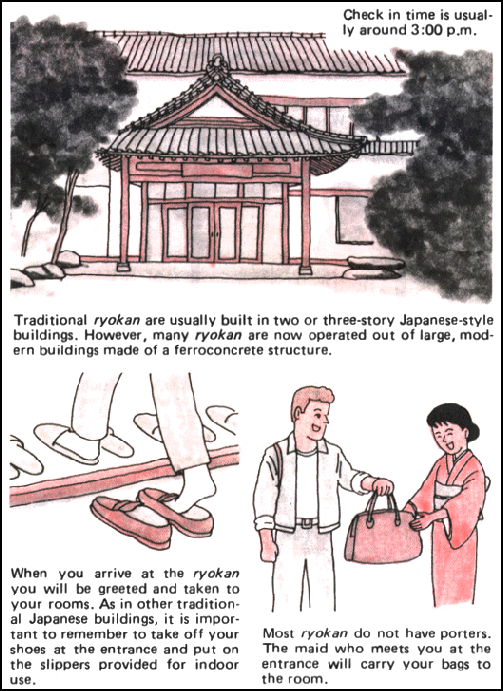
Ryokan and Minshuku
Ryokan are the most common kind of traditional Japanese inn found in Japan. Some 80,000 Ryokan are available in key cities and at tourist resorts throughout the country. Many are found in hot spring resorts. “Ryo” means travel, “kan” means inn.
A “ryokan” is an authentic Japanese-style hotel where long-held traditions are still observed. At the entrance, a woman welcomes the guests in a Japanese way and ushers them in. Shoes are removed and slippers are put on before stepping on the tatami (woven mat) floor. Guests are also provided with a “yukata”, a kimono-like outer garment, and “geta”, wooden clogs used for walking outdoors.
Each traditional Japanese-style room has a paper sliding door. During the day the room serves as a living and dining room, while at night, it is transformed in a bedroom with a futon (Japanese-style bed).
Some foreign tourist are shocked when they enter a room in a minshuku or a ryokon for the first time and find the room nearly devoid of furniture.
Meals are typically Japanese and dishes such as tempura, sashimi, and baked fish are usually offered. Soft drinks, sake and other alcoholic drinks are also usually available. Meals are generally served in the rooms but sometimes they are offered in a dining room. Rooms with and without attached baths are available, and one of the main features of a ryokan is large, relaxing Japanese-style bath.
Describing his ryokan experience Thomas Swick wrote in Smithsonian magazine: “Dinner was served in our room, on a table with greatly abbreviated legs. Our chairs were limbless, consisting of a back and pillowed seat. Sitting was going to be a bigger problem for me than walking. “In the numerous bowls and plates in front of me sat pink-and-white rectangles of carp sashimi, shredded mountain potato in raw egg and seaweed, three fishes slightly larger than matchsticks, one grilled freshwater fish, a watery egg custard with chicken and mushrooms, boiled daikon (radish) with miso, and vegetable tempura...The richness of the meal contrasted with the sparseness of the room. Bedding would be laid down on the tatami after dinner. There was no TV, but a small black rock sat on an embroidered pillow atop a wooden stand for our contemplation.” [Source: Thomas Swick, Smithsonian magazine, October 2010]
Ryokan vary a lot in price and quality. The average rate at a ryokan starts at about US$80 per night per person in the off season and US$100 in the busy season. The expensive ones can cost from $200 to $800 a night. Ask your nearest JNTO office for the “Japan Ryokan Guide” .Japan Ryokan Association, ☎ 03-3231-5310. Websities Japan Ryokan Association Japan Ryokan Association ; Japanese Guesthouses Japanese Guesthouses
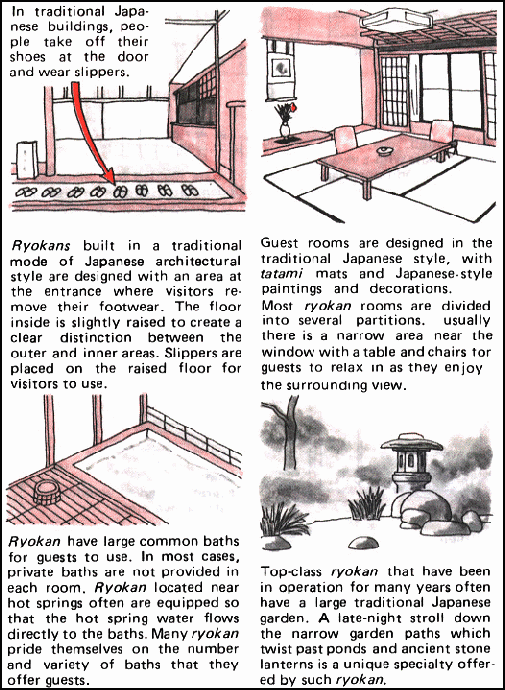
Minshuku is the Japanese equivalent of a guest house or bed and breakfast. Most are run by families who rent rooms out their home ro a building attached to their home. They are often found in popular resort and vacation spots, and feature moderate rates.
Unlike a hotel the atmosphere at “minshuku” is like that of a home. Guests, for example, are expected to fold up their bedding and put it away in the closet. Minshuku generally cost about US$60 to $130 a night per person and includes two family cooked meals. Sometimes in the countryside foreigners are told they are not welcome at the minshukus because they are too big for the baths, rooms, futons and yukatas. As is the case with ryokan the rooms are nearly devoid of furniture.
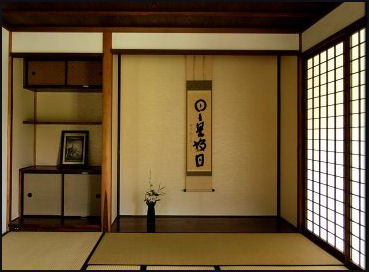
tatami mat roomMeals are served at a fixed time, generally around 7:30 or 8:00am and 6:00pm. Guests are served a tasty and filling set meal rather than ordering from a menu. A typical dinner consists of miso soup, soba noodles, mountains vegetables, egg custard, rice and main dish such as nabe (stew). river trout or even wild boar. Sometimes the breakfast is remarkably similar to the dinner except a fried egg is added.
More and more Japanese inns are charging separately for lodging and meals, with the meals optional, partly as a way to attract more foreign customers. Low-end inns, which are often still quite nice, charge ¥5,500 to ¥8,500 for lodging and between ¥3.500 and ¥5,000 for dinner and ¥1,000 for breakfast.
There are more than 3,000 minshuku nationwide. family
Often the staff doesn’t speak any English. A guide called “Minshuku in Japan” is available from JNTO. Recommended one are limited on the JNTO website under "reasonable accommodations." For more information call ☎ (03)-3216-6556. Website: Japanese Guesthouses Japanese Guesthouses
Welcome Inn is an organization that handles reservations for more than 500 ryokans, minshukas, pensions, Japanese inns, budget hotels and other types of accommodation that cost US$80 or less per night for a single room. The majority of Welcome Inns are small- to medium-sized, and are best suited to budget-minded individuals and small groups of family members or friends.
Facilities and service levels differ from inn to inn as well as do the foreign language comprehension levels of the staff. The Welcome Inn Reservation Center is operated by the International Tourism Center in close cooperation with the Japan National Tourist Organization. All Welcome Inns are require to have guest rooms which cost US$80 or less.
Reservations often need to made at least few days in advance. Welcome Inn headquarters is located in the Tokyo Kaian Building, 9th Floor, Yurakucho, Chiyoda-yu, Tokyo, ☎ (03)-3211-4201, fax: (03)-3211-9009. Website: Welcome Inn Center of Japan Welcome Inn Center of Japan
Japanese Inn Group consists of 70 or so ryokan that cater particularly to foreigners. Reservations can be made through the Welcome Inn Reservation Center. Rooms generally vary between US$35 and US$60 per person without meals. For more information call ☎ (03)-3822-2251 (Tokyo) or (075)-351-6748 (Kyoto), Website: Japan Inn Japan Inn
Onsens, See Activities
Capsule Hotels, Hostels and Temples in Japan
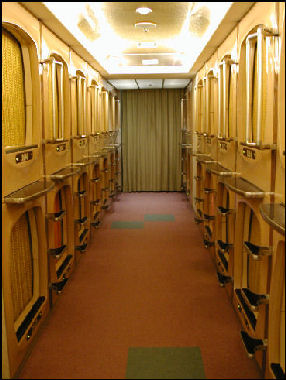
Capsule Hotels are often found in city entertainment districts usually clustered near train stations. They cost about $35 a night. Most of them are in Tokyo. They are used mostly by business people in a tight budget who find paying ¥4,000 for capsule more attractive than ¥7,000 for a room in a business hotel. A typical large capsule hotel occupies three floors of a multistory building and contains a bath house, a 24-hour cafeteria, and a couple hundred capsules.
The capsules are about six feet long, three feet wide, and three feet high and are equipped with bed, television and stereo. Made of molded plastic, they look sort of like the plastic cages used by animals on airline flights and are piled one on top of another and arranged in rows sort of like a morgue. They are entered at one end like a cave. The opening is covered by a pull-down rattan blind.
Capsule hotels are more busy on the weekdays than weekends. Many of the customers are businessman, too drunk, too tired to endure the train ride home, or who have spent too much time in the bars and pachinko parlors and missed the trains home. Describing a capsule hotel in Shinjuku in Tokyo, Michael Finkel wrote in the New York Times, "The first floor of the five-story building housed a pachinko parlor; the second, a night club. At the third floor, the elevator opened onto the reception area...A middle-aged man was stationed at a desk in front of a block of cubbies that contained footwear."
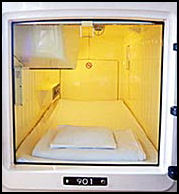
inside a capsule After bathing in a bath house, packed with naked salarymen, Finkel entered his capsule. "A small television was mounted on the ceiling of the capsule: two of the three channels were dedicated to pornographic offerings. There was also a radio, an alarm clock, a reading light (with a dimmer switch, a mirror...and an airplane-style air nozzle."
"Sleep did not come easily...just as I'd begun to dream, the first alarm went off, somewhere down the hallway. It was an ear-shattering, air-raid siren of a noise that bolted me upright, causing me to knock my head on the capsule's ceiling. It was 5 o'clock in the morning. No sooner had I realized what had happened and settled back under my sheet than another alarm sounded. And another. And then another — every few minutes.”
Many capsule hotels offer "cabins" with enough space for a small desk. They cost about ¥1,500 more than a capsule. In Osaka there are also nap hotels, where salarymen spend between $4.30 and $11.60 an hour to take a nap inside a tent in a room with 10 tents.
Youth Hostels are the cheapest accommodation option in Japan. They are simple and neat accommodation facilities geared particularly for young people. There were 288 youth hostels throughout Japan as of 2006. Of these 60 are run by the government and the remainder are privately operated.
Youth hostels are equipped with dining rooms, showers, and heating systems. Guests have traditionally slept in bunks or on tatami mat floors in large single-sex rooms. Some have communal kitchens and laundry services and private rooms and offer guest cheap meals. Some hostels have a curfew and lockout policy and require guests to do chores.
In Japan, many hostels have private rooms with shared baths and showers and a television. Japanese prefer to stay in private rooms than dormitories. These days hostels are becoming more popular with older people and less popular with younger people who are backpacking more overseas.
Most hostels charge US$25 to US$40 per person a night without meals and may require a valid Japanese Youth Hostel (JYH) or International Youth Hostel Federation (IYHF) membership card and . A wide variety of youth hostel publications are available. JNTO puts out a “Youth Hostel Map of Japan”. JYH publishes the “Youth Hostel Handbook” (mostly in Japanese).
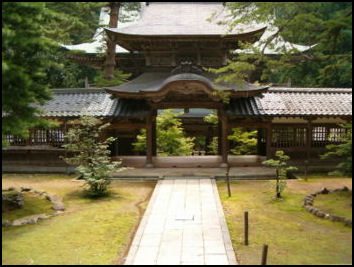
a temple that offers loding For further information contact Japan Youth Hostel (☎ 03-3288-1417, www.jyh.jp/); American Youth Hostel Inc. (P.O.Box 37613, Washington D.C. 20013-7613; ☎ 202-783-6161, Fax: 202-783-6171); or the American Youth Hostels Inc. Travel Center (1108 K St. NW, Washington DC, ☎ 202-783-4942). Hosteling International ( hiayh.org provides information of 5,000 hostels in 50 countries. Hosteling international USA membership cost $28 a year. Website: Japan Youth Hostels(click hostels for good map and description of hostels) Japan Youth Hostels
Temple Lodging (shukabo) is offered in Kyoto, Mt. Koyo and other places. For around ¥4,000 per person who get an austere tatami mat floor and vegetarian breakfast and are welcome to participate in the temple's prayers. The temples often have curfews and often guest are required to bath at a nearby public bath. Website:Temple Lodging in Japan Temple Lodging in Japan ;onmark productionsonmark productions;Japan Guide Mt. KoyaJapan Guide Mt. Koya
Other Accomodation Options in Japan
Pensions in Japan are generally nicer and more expensive than their counterparts in other parts of the world. Often located near ski resorts or near lakes, these lodging are strongly associated with outdoor sports. Most are located in rustic lodges and they are run by young couples. Sometimes they have a restaurant, a bar, laundry services or a notice board.
The atmosphere is usually friendly and the owners of the pensions are often times very helpful. They are also good places to meet other travelers. The average rate at pensions is about US$80 per night including two meals. JNTO puts out a guide called "Pensions in Japan."
People's Lodges (“ Kokumin Shukusha”) is one of the most popular forms of public sightseeing accommodation. They are moderately priced lodging mostly built in national parks. Some are privately owned and others are managed by the government. Guest rooms, baths and toilet facilities are Japanese-style. Guests are usually provided with a yukata cotton robe but are not always provided with towels. Kokumin Shukusha charge about US$55 per person per night.
Accommodations in Private Homes is generally not all that common in Japan. You can try writing the tourist office in the city, town or region you are interested in visiting. Request a list of persons renting rooms. The rooms are usually in the homes of working people and the they are generally clean and have toilet and washing facilities available. Website: Homestay in Japan (Google-sponsored site) Homestay I Japan

a mountain hut in the Japan AlpsGaijin Houses are places geared for long term stays. They generally offer rooms between $500 and $1,000 a month in the major cities. They advertise in English-language newspapers and entertainment guides. Websites:Gaijin House Japan Gaijin House Japan and Sakura House Sakura House
Weekly Mansion are tiny apartments with a tiny kitchen that charge around US$250 a week for a single and require a deposit of US$200.
Bed and Breakfasts: See Minshuku Above
Hotel Coupons include the Kinestsu International Stay and Save Hotel Plan (good for 11 hotels in 4 cities), the Nippon Travel Agency Hotel Pass (good for 54 hotels in 26 cities) and the Super Stop Travel System offered by Tokyu Tourist Corporation (good for 53 hotels in 36 cities).
Cheapest Accommodation Options include staying at a business hotel, hostel, a capsule hotel, or camping.
Camping is not really that popular in Japan. There are few campgrounds with modern facilities. Those that do exist tend to crowded, cramped and expensive for what you get. The national parks and mountain areas have camping areas for tent campers. JNTO publishes “Camping in Japan”.
For More Information on tourist hotels contact the Japan National Tourist Organization office or consult other guide books. Budget travelers should consult the Lonely Planet books.
Image Sources: 1) 2) Visualizing Culture, MIT Education 3) Kangawa Tourist Information 4) Japan Guest Houses 5) Japan reference 6) Shearatan 7) 8) JNtO 9) Ray Kinnane 10) 11) Strange and Funny Japan blog 12) Wikitravel 13) Matsumoto Tourism
Text Sources: New York Times, Washington Post, Los Angeles Times, Daily Yomiuri, Times of London, Japan National Tourist Organization (JNTO), National Geographic, The New Yorker, Time, Newsweek, Reuters, AP, Lonely Planet Guides, Compton’s Encyclopedia and various books and other publications.
